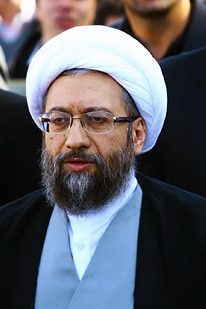
Since August 2009, Sadeq Ardeshir Larijani has served as the head of the Iranian judicial system as the chief of justice, appointed by the Supreme Leader Ali Khamenei. He is one of five brothers within the Larijani family, also called “Iran’s Kennedys,” as they all hold prestigious positions throughout various Iranian government agencies and are, both politically and through marriage, closely linked to Khamenei and his inner circle. A devout philosophers and conservative cleric Sadeq Larijani taught himself English after perfecting Quranic Arabic in order to better understand and combat what he calls “the Western cultural invasion.” His wife is the daughter of Grand Ayatollah Hossein Vahid Khorasani, one of his former teachers and one of the most widely followed religious leaders, whose rulings are regarded as binding by devout Shiites, which in turn puts Larijani and his family in high esteem among Iran’s religious inner circles.
Sadeq Larijani, born in 1960 in Najaf, is the son of Grand Ayatollah Hashem Amoli. Considered an intellectual, he studied theology and comparative philosophy at Qom Seminary, where he later taught as the head lecturer for commanders of the Islamic Revolutionary Guard Corp. He first gained attention in 1988 in a series of publications criticising both renowned Islamic intellectuals such as Abdolkarim Soroush and former President Muhammed Khatami, as well as publishing translations and criticisms of English philosophers and, according to his personal biography, dedicating his efforts toward fighting Western “cultural invasion” and to furthering the goals of the Islamic Republic.
In 1988, Larijani was elected to the Third Assembly of Experts. In 2001, he was appointed to the Council of Guardians as its youngest member. During his time in the Guardian Council, where he was responsible for approving laws related to supervisory elections, Larijani avoided public appearances and interviews. His appointment in 2009 by the supreme leader as the head of the judiciary in the months following the Green Movement protests was a surprise because Larijani lacked experience in Islamic law required for the post. But his appointment was a means by which Khamenei could exert control over Larijani and therefore the judicial system as a whole. The move did not help the continuing perception that the judicial system lacked credibility and impartiality. His 2009 appointment came after the initial government backlash against the Green Movement protesters, and Larijani oversaw the majority of prosecutions that resulted in harsh punishment.
Shortly after entering his post, Larijani appointed Saeed Mortazavi as deputy prosecutor general, who was later linked to the torture and deaths of anti-government protesters and journalists, which earned him the nickname, “The Butcher of the Press.” In 2010, Mortazavi was found responsible by the Iranian Parliament for dozens of human rights abuses and three death in the Kahrizak Detention Center. In November 2016, he was sentenced to 135 lashes for financial corruption.
Subsequently, the European Union sanctioned Sadeq Larijani for human rights abuses, holding him responsible as the head of the judiciary for approving harsh punishments for prisoners. This included implementing capital punishment, including for juveniles, as well as corporal punishments, which is allowed under Iranian law. The international condemnation, however, has not led to Larijani’s removal, and his time in office has paved the way for the security forces to continue their arbitrary arrests and persecution of lawyers, political figures, activists and dual-nationals at the highest rate since the 1979 Islamic Revolution.
Furthermore, Larijani’s actions in office have illustrated the extent of the supreme leader’s dominance over all aspects of Iranian politics, including punishing and hindering various political parties. Examples include the unprecedented closure of the National Confidence Party, and the arrest of outspoken politicians and their family members. As the head of the judiciary, Larijani continuously hindered former President Mahmoud Ahmadinejad’s power when the president fell out of favour with the supreme leader. This included the apprehension of Ahmadinejad’s former press advisor, Ali Akhbar Javanfekr, and denying the former president’s right to pardon or to access political prisons where individuals who both supported and opposed Ahmadinejad were being held. Larijani has similarly undermined the pragmatic and more internationally open administration of President Hassan Rouhani by opposing the lifting of a legal ban on social media, more liberal interpretation of laws regarding female modesty and a more open media.
To date, the judiciary under Larijani’s leadership has been found to be fraught with widespread corruption, which the supreme leader has acknowledged, resulting in the dismissals of judges and lawyers, and which marks the continued battle for power between the various political branches and alliances. Furthermore, the 77-year old Khamenei’s deteriorating health has raised questions about who will be selected as Iran’s next leader. Sadeq Larijani, with his powerful ties and position, has many times been mentioned as a possible contender.


